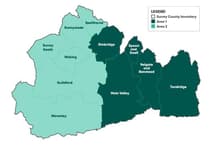The words ‘sophistication’ and ‘school dinners’ aren’t usually uttered in the same sentence.
Readers of a certain age can probably remember the questionable sustenance being dished up by apron-wearing ladies and the smell in the canteen. Yep, you’re there again, aren’t you?
But pupils in Surrey schools got a taste of the future 45 years ago in the biggest development since garlic bread.
Out went the traditional two-course lunch, and in came a new Eighties-style school meal.
The new menu, said councillors, brought in a “sophisticated look” to children’s lunches. But the introduction of other items would have ramifications in future years, and a campaign that went all the way to Downing Street.
The main dishes actually didn’t change that much with Shepherd’s Pie being a mainstay, for instance. But each item was offered separately.
The pupils could choose steak and kidney pie, or a cottage pie and then add other vegetable helpings to it, or have it on its own. It doesn’t sound like much, but this was verging on revolutionary at the time.
However, there was one change to the menu which Jamie Oliver definitely wouldn’t approve of today, and which may have altered waistlines in years to come.
The menu change also saw the introduction of snack type food for the first time, with cheese rolls, pizzas quiches and hot dogs as options.
.jpeg?width=752&height=500&crop=752:500)
Doughnuts, yogurts and fresh fruit would follow, so two out of three isn’t bad, we guess.
Surrey County Council invited journalists from the Herald and its counterparts to visit local schools that were trialling a combination of cafeteria style and the traditional school meal.
So our roving reporter, hungry for knowledge and a taste of the future, travelled to a primary school in Waverley Borough and joined the queue with pupils.
“It was found that about half the pupils who stayed to school lunches opted for the cafeteria style, while the others stayed faithful to the traditional school dinner,” said the unnamed reporter in his August 1980 report.
“Many of the schools who offered the two systems found that pupils were divided fifty-fifty in their choice.”
Veronica Hope, the area school meals advisor, was at the school to discuss the new system with the journalists attending.
She defended the new meals against the suggestion that it would give the pupils the opportunity to eat well not wisely, and fill up with starchy rolls and doughnuts. If only a young Mr Oliver had been in the room at the time.
She said: “It is better for them to choose a meal and eat it all, than to be served a well-balanced meal and leave half of it, with the greens and salads going in the dustbin.”
On the menu that day were hot dogs for 16p, pizzas at 18p, doughnuts 10p and filled rolls (cheese) 16p.
Pupils could even grab a coffee for nine pence. Even with today’s fondness for sugary and high-energy drinks, could you imagine that happening now?
Our reporter noted that the rolls were fresh and tasty, the coffee was as good or better than the 17 or 18p cups sold in many cafes, and the doughnuts were “large, soft and sugary.”
The fifty percent traditionalists tucked into steak pie, carrots and sauté potatoes followed by orange jellying marshmallow cream, for which they paid the current 40p school dinner price.
Standing true, tastes were changing among children; for instance, said Mrs Hope, cabbage is more popular than carrots as a second vegetable, and peas are losing favour. The one vegetable which was always successful was, of course, baked beans.
By Charlotte Jarman







Comments
This article has no comments yet. Be the first to leave a comment.